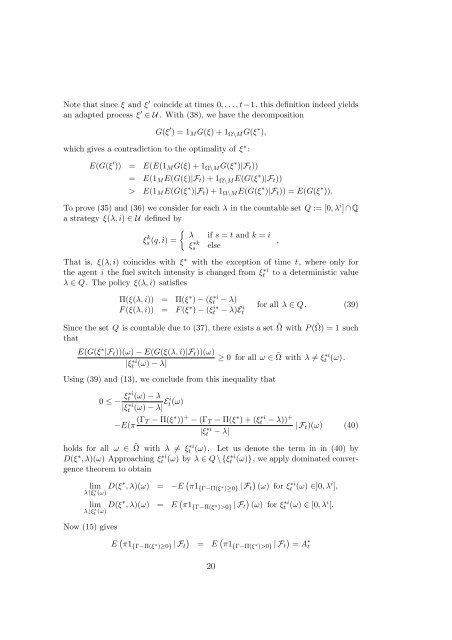A quantitative approach to carbon price risk modeling - CiteSeerX
A quantitative approach to carbon price risk modeling - CiteSeerX
A quantitative approach to carbon price risk modeling - CiteSeerX
Create successful ePaper yourself
Turn your PDF publications into a flip-book with our unique Google optimized e-Paper software.
Note that since ξ and ξ ′ coincide at times 0, . . . , t−1, this definition indeed yields<br />
an adapted process ξ ′ ∈ U . With (38), we have the decomposition<br />
G(ξ ′ ) = 1 M G(ξ) + 1 Ω\M G(ξ ∗ ),<br />
which gives a contradiction <strong>to</strong> the optimality of ξ ∗ :<br />
E(G(ξ ′ )) = E(E(1 M G(ξ) + 1 Ω\M G(ξ ∗ )|F t ))<br />
= E(1 M E(G(ξ)|F t ) + 1 Ω\M E(G(ξ ∗ )|F t ))<br />
> E(1 M E(G(ξ ∗ )|F t ) + 1 Ω\M E(G(ξ ∗ )|F t )) = E(G(ξ ∗ )).<br />
To prove (35) and (36) we consider for each λ in the countable set Q := [0, λ i ] ∩ Q<br />
a strategy ξ(λ, i) ∈ U defined by<br />
{<br />
ξs k λ if s = t and k = i<br />
(q, i) =<br />
,<br />
else<br />
ξ ∗k<br />
s<br />
That is, ξ(λ, i) coincides with ξ ∗ with the exception of time t, where only for<br />
the agent i the fuel switch intensity is changed from ξt<br />
∗i <strong>to</strong> a deterministic value<br />
λ ∈ Q. The policy ξ(λ, i) satisfies<br />
Π(ξ(λ, i)) = Π(ξ ∗ ) − (ξt ∗i − λ)<br />
F (ξ(λ, i)) = F (ξ ∗ ) − (ξt<br />
i∗ − λ)Et<br />
i<br />
for all λ ∈ Q. (39)<br />
Since the set Q is countable due <strong>to</strong> (37), there exists a set ˜Ω with P (˜Ω) = 1 such<br />
that<br />
E(G(ξ ∗ |F t ))(ω) − E(G(ξ(λ, i)|F t ))(ω)<br />
≥<br />
(ω) − λ|<br />
|ξ ∗i<br />
t<br />
Using (39) and (13), we conclude from this inequality that<br />
0 ≤ − ξ∗i t (ω) − λ<br />
|ξt ∗i(ω)<br />
− t(ω)<br />
λ|Ei<br />
0 for all ω ∈ ˜Ω with λ ≠ ξ ∗i<br />
t (ω).<br />
−E(π (Γ T − Π(ξ ∗ )) + − (Γ T − Π(ξ ∗ ) + (ξt ∗i − λ)) +<br />
|ξt ∗i<br />
| F t )(ω) (40)<br />
− λ|<br />
holds for all ω ∈ ˜Ω with λ ≠ ξt ∗i (ω). Let us denote the term in in (40) by<br />
D(ξ ∗ , λ)(ω) Approaching ξt ∗i (ω) by λ ∈ Q \ {ξt ∗i (ω)}, we apply dominated convergence<br />
theorem <strong>to</strong> obtain<br />
lim<br />
λ↑ξt ∗(ω) D(ξ∗ , λ)(ω) = −E ( )<br />
π1 {Γ−Π(ξ ∗ )≥0} | F t (ω) for ξ<br />
∗i<br />
t (ω) ∈]0, λ i ],<br />
lim<br />
λ↓ξt ∗(ω) D(ξ∗ , λ)(ω) = E ( )<br />
π1 {Γ−Π(ξ ∗ )>0} | F t (ω) for ξ<br />
∗i<br />
t (ω) ∈ [0, λ i [.<br />
Now (15) gives<br />
E ( π1 {Γ−Π(ξ ∗ )≥0} | F t<br />
)<br />
= E<br />
(<br />
π1{Γ−Π(ξ ∗ )>0} | F t<br />
)<br />
= A<br />
∗<br />
t<br />
20
















